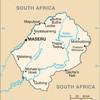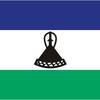Lesotho [+]Compare [E]dit [H]istory
Aliases: Basutoland, Kingdom of LesothoObject «Lesotho» was created due to
Add new object to «Lesotho» or move existing objects here.
Object «Lesotho» has attributes [Show empty attributes][Hide empty attributes]
| Attribute | Value |
|---|---|
| Geography | |
| Area | 30,355 km² |
| Continent | Africa |
| Land area | 30,355 km² |
| Water area | 0 km² |
| Land boundaries | 1,106 km |
| Border countries |
|
| Coastline | 0 km |
| Mean elevation | 2,161 m |
| Lowest point | 1,400 m |
| Highest point | 3,482 m |
| People | |
| Population | 1,969,334 |
| Official languages |
|
| Religion | Protestant |
| Government | |
| Long country name | Kingdom of Lesotho |
| Short country name | Lesotho |
| Long local name | Kingdom of Lesotho |
| Short local name | Lesotho |
| Former name |
|
| Government type | Parliamentary constitutional monarchy |
| Capital | Maseru |
| Economy | |
| GDP (PPP) | 6,656,000,000 USD |
| GDP (OER) | 2,749,000,000 USD |
| GDP (real growth rate) | -1.6 % |
| GDP - per capita (PPP) | 3,300 USD |
| Gross national saving | 20.3 % of GDP |
| Labor force | 930,800 |
| Unemployment rate | 28.1 % |
| Population below poverty line | 57 % |
| Budget revenues | 1,090,000,000 USD |
| Budget expenditures | 1,255,000,000 USD |
| Military expenditures | 1.81 % of GDP |
| Taxes and other revenues | 39.7 % of GDP |
| Budget surplus or deficit | -6 % of GDP |
| Public debt | 33.7 % of GDP |
| Inflation rate | 5.3 % |
| Central bank discount rate | 6.75 % |
| Commercial bank prime lending rate | 11.58 % |
| Stock of narrow money | 420,800,000 USD |
| Stock of broad money | 420,800,000 USD |
| Stock of domestic credit | 442,300,000 USD |
| Market value of publicly traded shares | Add |
| Current account balance | -102,000,000 USD |
| Exports | 1,028,000,000 USD |
| Imports | 1,826,000,000 USD |
| Reserves of foreign exchange and gold | 657,700,000 USD |
| External debt | 934,600,000 USD |
| National currency | maloti |
| National currency (code) | LSL |
| National currency (symbol) | L |
| National currency rate to USD | 14.48 |
Basutoland was renamed the Kingdom of Lesotho upon independence from the UK in 1966. The Basotho National Party ruled the country during its first two decades. King MOSHOESHOE II was exiled in 1990, but returned to Lesotho in 1992 and was reinstated in 1995 and subsequently succeeded by his son, King LETSIE III, in 1996. Constitutional government was restored in 1993 after seven years of military rule. In 1998, violent protests and a military mutiny following a contentious election prompted a brief but bloody intervention by South African and Botswana military forces under the aegis of the Southern African Development Community. Subsequent constitutional reforms restored relative political stability. Peaceful parliamentary elections were held in 2002, but the National Assembly elections in 2007 were hotly contested and aggrieved parties disputed how the electoral law was applied to award proportional seats in the Assembly. In 2012, competitive elections involving 18 parties saw Prime Minister Motsoahae Thomas THABANE form a coalition government - the first in the country's history - that ousted the 14-year incumbent, Pakalitha MOSISILI, who peacefully transferred power the following month. MOSISILI returned to power in snap elections in February 2015 after the collapse of THABANE’s coalition government and an alleged attempted military coup. In June 2017, THABANE returned to become prime minister.
Similar objects
Most often compared with
Everyone can something to edit or add.
There was one edit, no edits waiting approval. Last edited by wilkinson.michael(9581), Sep 16, 2019 (62 fields were changed)
Help · Contact us · Disclaimer · Contributors · Developers · Donate


